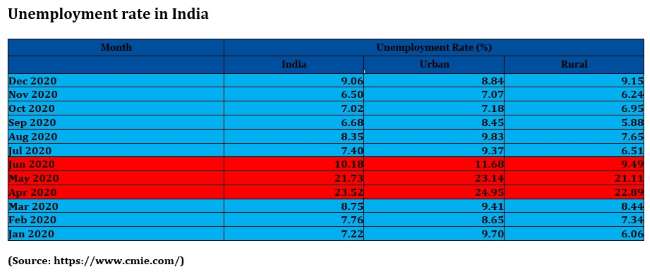
Finance Minister Nirmala Sitharaman must be giving finishing touches to Union Budget 2021 that will be presented on February 1 in the Lok Sabha. The Covid-19 pandemic and the lockdown have adversely impacted the Indian economy. According to the government estimates, the economy will contract by 7.7%, while the World Bank has predicted a 9.6% contraction. The FM has also raised the hopes by stating that this budget will be unlike anything in the past 100 years. Sitharaman has her task cut out for Budget 2021. It has to revive the pandemic-stricken economy and take it to a sustainable high growth trajectory.
The most tragic aspect of the disruptions in the economy was seen in the employment landscape. Unemployment rate shot up as the coronavirus outbreak led to the closure of industries, services, and other businesses. The unemployment rate skyrocketed from 6.7% on March 15, 2020 to 26% on April 19. However, the effects varied from one section to another.
READ I Budget 2021 should learn Covid-19 lessons, strengthen public health system
Employment generation top priority of Budget 2021
Small traders and labourers suffered the most due to the Covid-19 pandemic, with nearly a hundred million Indians losing jobs. This was worrisome as India was facing a high unemployment levels even before the coronavirus outbreak. The agriculture sector saw an increase in employment because of reverse migration as many daily-wage earners who lost employment in the urban areas returned villages and took up farming.


READ I Budget 2021: Ideas to put Indian economy back on track
The table reveals a high unemployment rate in urban areas compared with rural areas in 2020 (except in December), which hints at the loss of salaried jobs or job in the formal sector. In India, salaried jobs are more prevalent in urban centres, but even there formal jobs are a modest proportion (21-22 %) of overall employment. Formal jobs help create informal jobs for household helps, drivers, and street vendors, as well as small service providers like plumbers/ electricians.
Salaried jobs are not only preferred by people in general as they offer steady earnings for households, they also benefit the economy by building up savings. People with formal jobs are in a position to plan their expenditure and seek loans as they are more assured about continued earnings. The sectors that bore the brunt of the lockdown were hospitality, real estate, aviation, and consumer durables industries such as automobiles and white goods. All these sectors generate formal jobs not only in the production lines, but also in associated services like marketing, sales and after-sales services. It had a serious spill-over effect on employment in other sectors.
The loss of jobs for the self-employed and informal labourers is a temporary phenomenon, but it is not the case in full-time salaried jobs. It may not be easy to get back to work at the same level and remuneration in case of salaried jobs. Thus, the Budget 2021 proposals need to focus on creating formal jobs across sectors — in agriculture, manufacturing, in MSMEs and large MNCs, and in large cities and smaller towns.
READ I Union Budget 2021: Seven ideas to transform Indian agriculture
While the pandemic and the subsequent economic crisis have affected all sectors of the economy, here are some sectors that need special attention of finance minister Nirmala Sitharaman while preparing Budget 2021.
Steel sector and engineering industry
The prices of primary steel products like HR strips/coils have touched a record high in the last six months, putting pressure on automobile and white goods manufacturers. At a time when demand in the automobile and other consumer durables sectors have started to pick up, an increase in the cost of main inputs is a major cause of concern as the cascading effect will jack up prices of the end products, affecting demand.
The adverse effects of the rise in steel prices are not expected to be confined to consumer durables only, it is bound to raise the cost of infrastructure projects too. Then, the MSME sector using steel for various fabrication works are also bearing the brunt of the price rise, and have requested government intervention to stabilise steel prices to stay competitive in export markets.
Spiralling prices of steel would equally impact the cost of residential and other housing projects, putting more stress on the real estate sector. Not surprising that Union minister for highways Nitin Gadkari, who is also holding the MSME portfolio, has blamed steel and cement producers for indulging in cartelisation to jack up prices. The steel makers say they are forced to raise prices because of an increase in the prices of iron ore that have more than doubled since June 2020. They have demanded a ban on exports of iron ore from India to stabilize the prices, a proposal opposed by mineral producers.
READ I Covid-19 economic packages must address women’s distress
The price of iron ore was in the range of $70-$120 per million tonne till August 2020. The prices are hovering around $170 per MT ay present. True, global prices of iron ore have gone up substantially owing to disruptions caused by natural calamities in Brazil and Australia, the two nations that have a major influence on the supplies and prices. With the iron ore mines in Goa closed, increasing exports from mines in Odisha and elsewhere, the domestic prices of iron ore, the most important input for steel making, is spiraling up.

Though India has an abundance of iron ore, the auction procedure, delay in operating of the leased mines, the Supreme Court order to close Goa mines, and lower than targeted production from operational mines have resulted in a shortfall in domestic iron ore supply. During 2019-20, China accounted for 81% of the total export of iron ore from India.
READ I Trade negotiations: How can India strike a strategic balance
Another major input in steel making, namely coking coal, is scarce in our country both in quantity and quality terms. This has resulted in dependence on countries like Australia, and Indonesia. This market has been volatile with prices of different grades fluctuating between $80 per tonne and $190 per tonne. Indian steel producers also shell out more for power and transportation compared with their counterparts abroad. All these factors have compelled them to raise the selling price of steel. The following measures are suggested for the industry.
- Increase the local output of iron ore through opening up more mines, and improving transport infrastructure would stabilize the price and supply situation.
- Export of iron ore may be banned as a temporary measure till the domestic supply of iron ore increases to take care of the production target.
- Cut in the import duty of coking coal to zero.
- Steel producers using the electric arc furnace to produce steel may be offered subsidised power supply as our power tariffs are amongst the highest in the world, making them uncompetitive in the global market.
How Budget 2021 can help pharma sector
India is now referred as the pharmacy of the world. But the country is dependent on China for the supply of almost 70% of the bulk drugs required for producing generic formulations. Of late, China is also increasing its presence in drug formulations space. Recent data shows a three-times increase in China’s global share of formulations exports. The bulk of China’s exports are going to the EU and North America that have stringent quality requirements.
READ I Budget 2021: Need higher healthcare spending, holistic approach
India, accordingly, needs to have a roadmap to strengthen its pharma industry. It must step up domestic production of bulk drugs to strengthen the domestic pharma industry. The attractiveness of bulk drugs import from China lies in low prices. The drug formulations producers imported raw materials worth around $2.4 billion from China in 2018-19. In order to encourage local bulk drugs production, the following steps are suggested.
- The scale of production is the key to produce drugs at a competitive cost; hence, the top Indian pharma producers with an impressive export profile need to be encouraged through financial incentives to set up upstream facilities to produce their requirements of intermediate drugs required in their production cycle.
- In addition to the incentives announced under the PLI scheme, it would be prudent to incentivize production cost as well as their exports made by existing units. The rate at which customs duty for import of basic chemicals/ consumables, and capital goods for the projects are applied are also listed as hindrances for starting bulk drug production.
- Another issue highlighted by pharma producers is the difficulties faced in procuring environmental clearances for greenfield projects, needs to be taken up as an EoDB measure.
Agriculture, storage, transportation, and food processing
The ongoing farmers’ agitation has impacted the farmer-friendly image of the government, and the Budget 2021 must send across a soothing message. It must be acknowledged that this sector propped up the Indian economy during the lockdown-induced downturn. Thus, farmer’s welfare should be on top of the finance minister’s agenda in Budget 2021. By happy chance, a robust monsoon and a good farming output have led to a spurt in demand for two-wheelers, tractors, and agriculture inputs in the final months of 2020. This is an opportune time for the government to announce policy initiatives to support the rural economy.
READ I A ticking time bomb: Tackling India’s mental health crisis
The target to double farmers’ income may not be achieved by the 2022 deadline with a growth rate of 3% in the agriculture sector. A concerted effort needs to be taken with a special focus on (i) high crop realisations or increasing agriculture productivity, and (ii) improvement of post-harvest infrastructure to add value. The forthcoming budget must, therefore, increase the central allocation to schemes for irrigation, crop insurance through PMFBY, fertilisers, rural connectivity, warehousing, and cold storage.
Some of the specific recommendations are as under:
Boost edible oil output
India, the world’s largest importer of edible oil, consumes around $10 billion worth of edible oils annually accounting for 2% of our total imports. Palm oil, sunflower oil, and soya oil are the three top grades of oils being imported. Together with other categories imported, they meet 70% of the domestic requirements. To achieve self-sufficiency in edible oil, there is a need for another “yellow revolution” on the lines of the earlier one launched in 1986.
Promoting the use of hybrid seeds, and other technological inputs to enhance productivity in the edible oilseeds sector has to be a priority as India’s average per hectare yield of oilseeds is 50% lower than the global average. However, Budget 2021 should focus on the entire value chain from the farmer to storage, transportation, and the processor. Budgetary allocation is needed for setting up storage and transportation facilities in rural and semi-urban areas to reduce India’s import bill. This will also help in raising the income of the farmers.
READ I How disruptive technologies are changing global trade
Adopting new farming techniques
While India has achieved self-sufficiency in grain production, the traditional agriculture practices are highly resource-intensive and have raised serious sustainability issues putting stress on water resources. A reorientation of policies and practices is needed to safeguard against desertification and land degradation. Besides, the plight of small (less than 2 ha holding) and marginal farmers (less than 1ha holding) who make up almost 85% of the farming community is pathetic due to low productivity.
The government’s efforts to double farmers’ incomes can be achieved by adopting new farming techniques such as localised application of agrochemicals, use of hybrid seeds to withstand water with greater salinity, insect-resistant crops, and the use of sensors and satellites to know the status of nutrients in crops. Digital technology can guide the right crop and input selection, and thus, reduce too much dependency on paddy and wheat.
A Smart Farming scheme in partnership with state governments can provide assistance to small farmers in selection of the right crop and appropriate inputs. This could be used for raising awareness about the use of digital tools for raising productivity in their limited land holdings. An allocation for this purpose in Budget 2021 could be a good beginning.
READ I Online education: Govt must enforce standardisation, regulation of EdTech firms
Hospitality and tourism sector
The arrival of Covid-19 vaccines and a well laid out vaccination program have raised the hopes of a near-normal life around the globe. If vaccines give the desired level of immunity as the tests and trials have predicted, the travel and hospitality sector is expected to see a revival of demand by mid-2021. The tourism industry has the potential to address the unemployment problem as it can create a large number of jobs in the hotel-hospitality industry, transportation industry, and related services like travel agencies.
Apart from employment generation, tourism growth contributes to the national economy by earnings in foreign exchange with the arrival of foreign tourists, creation of infrastructure facilities, and socio-economic well beings of the local population. According to the World Travel and Tourism Council, the tourism sector generated $240 billion of revenue equivalent to 9.2% of India’s GDP in 2018 and supported 42.6 million jobs, 8.1% of our total employment.
Tourism is the only sector of the Indian economy that employs par with its percentage contribution to national GDP, and thus, merits special focus of policymakers for generating employment. The following steps for the promotion of the tourism and hospitality industry under Budget 2021 are suggested:
- Professional education and skill development for the tourism sector need to be a priority to bring about more professionalism in tourism promotion activities. Higher grant for setting up institutes to impart such training may be considered in partnership with the state governments.
- The development of modern highways has contributed immensely to achieving double-digit growth in the tourism sector in the past. The emphasis on connectivity by the introduction of fast trains like Tejas, and bringing more tier II & III cities on aviation map on the lines of the Udaan scheme needs to be continued.
- Religious tourism is a big component of the Indian travel sector, the potential of which has not been realized. It is not limited to Char Dham, Tirupati, or Ma Vaishno Devi which of course are major religious destinations. Places like twelve Jyotirlingas or the 51 Shakti Peethas are significant shrines and pilgrimage destinations, most of which lack both connectivity and good lodging facilities.
Newsprint industry needs support
The newspaper publishing sector has been hit hard due to Covid-19 pandemic and publishers have requested the government for a waiver of 5% import duty on newsprint. However, the Indian Newsprint Manufacturing Association (INMA) is in favour of restricting the import of newsprint as a large part of their installed capacity remains unutilised.
Both the sides are hit by the pandemic and the lockdown, and the government needs to do a critical balancing act. Under the circumstances, the revival of closed newsprint manufacturing units should be a priority to reduce the import bill that currently stands at $750 million per annum. An increase in domestic production of newsprint would help stabilise the supply position and moderate prices which is the main concern of newspaper publishers.
(Krishna Kumar Sinha is an industrial policy and FDI expert based in New Delhi. His last assignment was as an industrial adviser in the department of industrial policy and promotion, DIPP, currently known as DPIIT, under the ministry of commerce and industry of the government of India.)
Krishna Kumar Sinha is an industrial policy and FDI expert based in New Delhi. His last assignment was as an industrial adviser in the department of industrial policy and promotion, DIPP, currently known as DPIIT, under the ministry of commerce and industry of the government of India.

